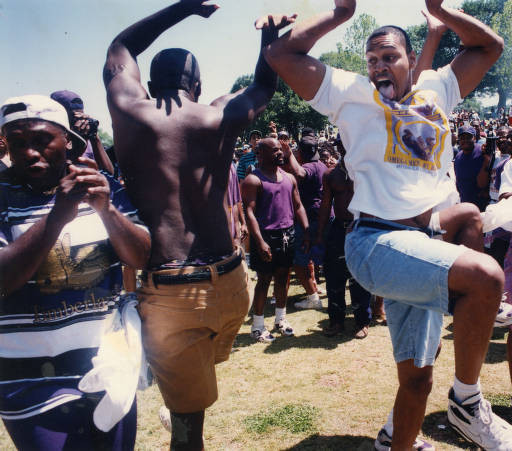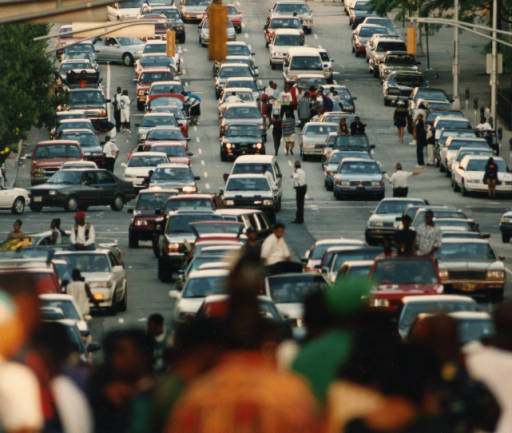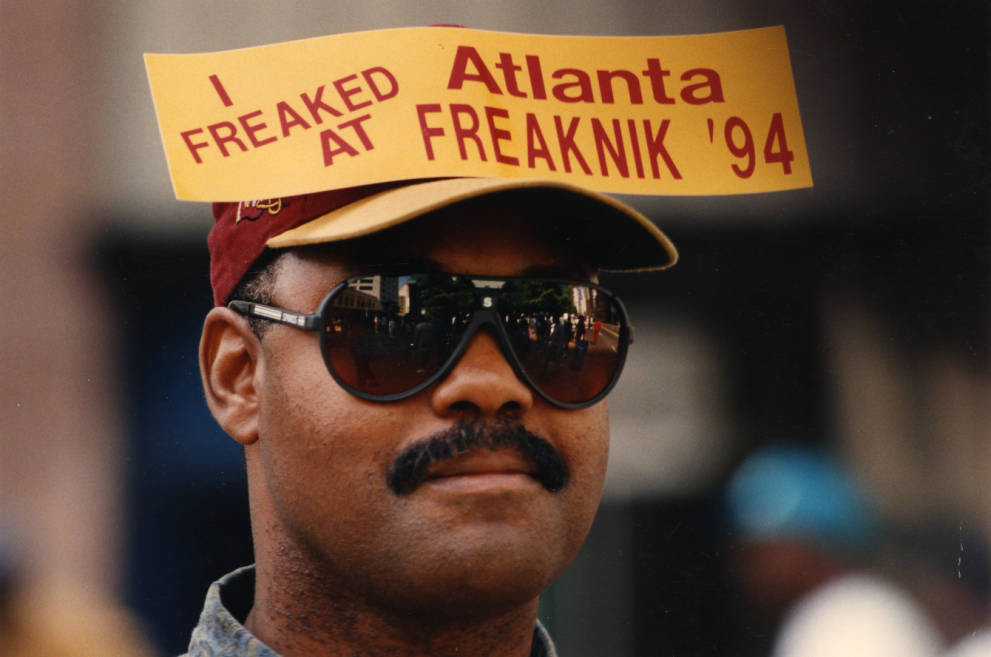Are you curious about what boosted tourism in Atlanta during the 1990s? SIXT.VN uncovers the key factors that transformed Atlanta into a popular tourist destination, from hosting major events to celebrating its unique cultural identity. Explore how these developments made Atlanta a must-see destination, offering convenient travel services and unforgettable experiences. Discover how Atlanta’s appeal grew and consider booking your own trip to explore this dynamic city with the assistance of SIXT.VN for seamless travel arrangements.
1. What Were The Primary Drivers Behind The Surge In Atlanta Tourism During The 1990s?
Atlanta experienced a significant increase in tourism in the 1990s primarily due to hosting the 1996 Olympic Games and the rise of Freaknik. According to research from the Atlanta Convention & Visitors Bureau in 1996, the Olympic Games alone brought in over 2 million visitors and generated an estimated $5.1 billion in economic impact, making it a pivotal event in Atlanta’s tourism history. Hosting the Olympics put Atlanta on the global map. This event showcased the city’s infrastructure, hospitality, and attractions to an international audience.
1.1. The 1996 Olympic Games As A Catalyst
Hosting the 1996 Olympic Games was a watershed moment for Atlanta. The city underwent significant infrastructural improvements, including upgrades to its transportation system, expansion of accommodation facilities, and enhancement of public spaces. These developments not only facilitated the smooth operation of the Games but also laid the foundation for sustained tourism growth in the years that followed.
The Olympic Games not only showcased Atlanta’s ability to host large-scale international events but also left a lasting legacy of improved infrastructure and enhanced tourism amenities. According to a study by Georgia State University’s Center for Economic Analysis, the long-term impact of the Olympics extended beyond the immediate economic gains, contributing to Atlanta’s reputation as a world-class destination for business and leisure travelers alike.
1.2. Freaknik’s Impact On Atlanta’s Cultural Scene
Freaknik, an annual street party that celebrated black culture, also contributed to Atlanta’s rise as a tourist destination in the 1990s. While it had its share of controversies, Freaknik drew hundreds of thousands of visitors to the city each year, injecting significant revenue into the local economy.
 Freaknik 94
Freaknik 94
Freaknik highlighted Atlanta as a center for black culture and entertainment. This event attracted a diverse crowd, contributing to the city’s reputation as a vibrant and inclusive destination. Despite the challenges it posed, Freaknik became an integral part of Atlanta’s identity in the 1990s, shaping its cultural landscape and attracting visitors from across the country.
1.3. The Role Of Hartsfield-Jackson Atlanta International Airport
Hartsfield-Jackson Atlanta International Airport, one of the world’s busiest airports, played a crucial role in facilitating the influx of tourists to Atlanta during the 1990s. With its extensive network of domestic and international flights, the airport served as a gateway to the city, making it easily accessible to travelers from all corners of the globe. According to a report by the Federal Aviation Administration, Hartsfield-Jackson Atlanta International Airport handled over 60 million passengers annually in the 1990s, solidifying its position as a major transportation hub.
2. What Infrastructural Developments Supported Atlanta’s Tourism Boom?
Atlanta’s tourism boom in the 1990s was supported by significant infrastructural developments, notably improvements to transportation networks and expansions in accommodation options. According to data from the Atlanta Regional Commission in 1995, these enhancements were critical in handling the increased influx of visitors, particularly during the 1996 Olympic Games.
2.1. Transportation Infrastructure Upgrades
The city invested heavily in upgrading its transportation infrastructure to accommodate the influx of visitors. The expansion of the MARTA rail system and improvements to major highways, such as I-75 and I-85, played a crucial role in easing traffic congestion and facilitating the movement of tourists around the city. The Georgia Department of Transportation reported that the highway improvements alone cost over $500 million, significantly enhancing Atlanta’s accessibility.
2.2. Expansion Of Accommodation Options
To cater to the growing number of tourists, Atlanta witnessed a significant expansion in its accommodation options during the 1990s. New hotels, motels, and vacation rentals sprang up across the city, offering a wide range of choices to suit different budgets and preferences. According to the Atlanta Convention & Visitors Bureau, the number of hotel rooms in Atlanta increased by over 30% during the decade, providing ample accommodation for visitors.
2.3. Development Of Tourist Attractions
Atlanta’s tourism boom in the 1990s was not solely driven by infrastructural developments but also by the creation and enhancement of various tourist attractions. The Georgia Aquarium, which opened in 2005, became a major draw, attracting millions of visitors each year. The Centennial Olympic Park, built for the 1996 Olympic Games, transformed into a permanent public space, hosting events and festivals year-round. These developments added to Atlanta’s appeal as a vibrant and dynamic tourist destination.
3. How Did The 1996 Olympic Games Affect Atlanta’s Economy And Tourism?
The 1996 Olympic Games had a profound and lasting impact on Atlanta’s economy and tourism industry. According to a study by the University of Georgia’s Terry College of Business, the Games generated an estimated $5.1 billion in economic impact for the city, making it one of the most successful Olympic Games in terms of economic benefits.
3.1. Economic Benefits From The Olympic Games
The economic benefits of the 1996 Olympic Games extended beyond the immediate influx of tourists and revenue. The Games stimulated investment in infrastructure, created jobs, and boosted the local economy. A report by the Metro Atlanta Chamber of Commerce indicated that the Games led to the creation of over 77,000 jobs in Atlanta, providing employment opportunities for residents and contributing to the city’s economic growth.
3.2. Increased Tourist Arrivals
The 1996 Olympic Games significantly increased tourist arrivals to Atlanta. The city welcomed visitors from all over the world, who came to witness the spectacle of the Games and experience the city’s attractions. According to the Atlanta Convention & Visitors Bureau, tourist arrivals to Atlanta increased by over 40% in the year of the Games, cementing its status as a top tourist destination.
 Traffic During Freaknik
Traffic During Freaknik
3.3. Long-Term Effects On Tourism
The long-term effects of the 1996 Olympic Games on Atlanta’s tourism industry were substantial. The Games raised Atlanta’s profile as a world-class destination, attracting both leisure and business travelers in the years that followed. The city’s enhanced infrastructure, improved amenities, and positive image contributed to sustained tourism growth, making it a popular choice for conferences, conventions, and events.
4. What Role Did Cultural Events Like Freaknik Play In Attracting Tourists To Atlanta?
Cultural events like Freaknik played a significant role in attracting tourists to Atlanta during the 1990s. According to an article in the Atlanta Journal-Constitution, Freaknik drew hundreds of thousands of visitors to the city each year, injecting millions of dollars into the local economy.
4.1. The Popularity Of Freaknik
Freaknik, an annual street party that celebrated black culture, gained immense popularity in the 1990s, attracting college students and young adults from across the country. The event featured music, dancing, fashion, and a vibrant street scene, creating a unique and exciting atmosphere that drew visitors to Atlanta.
4.2. Economic Impact Of Freaknik
The economic impact of Freaknik on Atlanta was substantial. The event generated revenue for local businesses, including hotels, restaurants, and retailers. According to a report by the Atlanta Business Chronicle, Freaknik contributed over $50 million to the city’s economy each year, making it a significant source of revenue for Atlanta.
4.3. Controversies Surrounding Freaknik
Despite its popularity and economic benefits, Freaknik also faced controversies. Concerns were raised about traffic congestion, crime, and public safety issues associated with the event. These controversies led to increased scrutiny from city officials and efforts to regulate and control Freaknik, ultimately contributing to its decline in the late 1990s.
5. How Did Atlanta Leverage Its Status As The “Black Mecca” To Boost Tourism?
Atlanta leveraged its status as the “Black Mecca” to boost tourism by promoting its rich African American heritage, cultural attractions, and vibrant arts scene. According to Ebony Magazine, Atlanta has long been recognized as a center for black culture, education, and economic opportunity, attracting visitors interested in exploring its unique identity.
5.1. Promotion Of African American Heritage
The city actively promoted its African American heritage through museums, historic sites, and cultural events. The Martin Luther King Jr. National Historic Site, the APEX Museum, and the National Center for Civil and Human Rights are among the attractions that showcase Atlanta’s role in the Civil Rights Movement and its contributions to African American history.
5.2. Showcasing Cultural Attractions
Atlanta showcased its cultural attractions, including its vibrant arts scene, music venues, and culinary offerings, to attract tourists. The city’s theaters, galleries, and music festivals highlighted the talents of African American artists and performers, drawing visitors interested in experiencing its cultural richness.
5.3. Marketing To African American Tourists
Atlanta actively marketed itself to African American tourists through targeted advertising campaigns and partnerships with black-owned businesses and organizations. The city emphasized its welcoming atmosphere, diverse community, and opportunities for cultural exploration, appealing to African American travelers seeking authentic experiences.
6. What Marketing Strategies Were Used To Promote Atlanta As A Tourist Destination?
Atlanta employed a variety of marketing strategies to promote itself as a tourist destination, including advertising campaigns, public relations efforts, and partnerships with travel agencies and tourism organizations. According to a report by the Travel Industry Association of America, effective marketing plays a crucial role in attracting tourists and boosting tourism revenue.
6.1. Advertising Campaigns
The city launched advertising campaigns in national and international markets to raise awareness of Atlanta’s attractions and amenities. These campaigns utilized print, television, and digital media to showcase Atlanta’s landmarks, cultural events, and unique experiences, targeting potential visitors with compelling messages.
6.2. Public Relations Efforts
Atlanta invested in public relations efforts to generate positive media coverage and enhance its image as a tourist destination. The city hosted journalists, travel writers, and influencers, providing them with firsthand experiences of Atlanta’s attractions and hospitality. Positive media coverage helped to build awareness and credibility, attracting more visitors to the city.
 Sitting on Stopped Cars at Freaknik ATL
Sitting on Stopped Cars at Freaknik ATL
6.3. Partnerships With Travel Agencies And Tourism Organizations
Atlanta forged partnerships with travel agencies and tourism organizations to promote the city as a destination and facilitate bookings. These partnerships involved joint marketing initiatives, familiarization trips for travel agents, and the development of travel packages that showcased Atlanta’s attractions and experiences. Collaboration with industry partners helped to expand Atlanta’s reach and attract more tourists.
7. How Did The City Balance Tourism Growth With The Needs Of Its Residents?
Balancing tourism growth with the needs of its residents was a key challenge for Atlanta during the 1990s. According to a study by the Brookings Institution, cities that successfully manage tourism growth prioritize community engagement, sustainable development, and equitable distribution of benefits.
7.1. Community Engagement
The city prioritized community engagement by involving residents in the planning and decision-making processes related to tourism development. Public forums, neighborhood meetings, and advisory committees provided platforms for residents to voice their concerns, share their ideas, and shape the direction of tourism initiatives.
7.2. Sustainable Development
Atlanta pursued sustainable development practices to minimize the negative impacts of tourism on the environment and local communities. The city promoted eco-friendly tourism initiatives, invested in green infrastructure, and implemented policies to protect natural resources and cultural heritage.
7.3. Equitable Distribution Of Benefits
The city aimed to ensure the equitable distribution of tourism benefits by supporting local businesses, creating job opportunities for residents, and investing in community development projects. The city also implemented policies to address issues such as affordable housing, transportation access, and social equity, ensuring that all residents could benefit from tourism growth.
8. What Lessons Can Other Cities Learn From Atlanta’s Tourism Boom In The 1990s?
Other cities can learn several valuable lessons from Atlanta’s tourism boom in the 1990s, including the importance of strategic planning, infrastructure investment, and community engagement. According to a report by the Urban Land Institute, successful tourism destinations prioritize long-term sustainability, inclusivity, and resilience.
8.1. Strategic Planning
Atlanta’s success in attracting tourists during the 1990s was partly due to its strategic planning efforts. The city developed a comprehensive tourism plan that identified key target markets, prioritized infrastructure investments, and outlined marketing strategies to promote Atlanta as a destination.
8.2. Infrastructure Investment
The city’s commitment to infrastructure investment was another key factor in its tourism boom. Atlanta invested heavily in upgrading its transportation networks, expanding accommodation options, and developing tourist attractions, creating a welcoming and accessible environment for visitors.
8.3. Community Engagement
Atlanta’s approach to community engagement provides a valuable lesson for other cities seeking to balance tourism growth with the needs of their residents. By involving residents in the planning and decision-making processes, the city ensured that tourism initiatives were aligned with community values and priorities.
9. How Did Atlanta Adapt To Changing Tourism Trends After The 1990s?
After the 1990s, Atlanta adapted to changing tourism trends by diversifying its tourism offerings, embracing technology, and focusing on sustainability. According to a report by Tourism Economics, destinations that adapt to evolving traveler preferences and embrace innovation are best positioned for long-term success.
9.1. Diversification Of Tourism Offerings
The city diversified its tourism offerings by developing new attractions, events, and experiences that appealed to a wider range of visitors. Atlanta invested in cultural attractions, culinary tourism, outdoor recreation, and niche markets such as film tourism and sports tourism, broadening its appeal and attracting new segments of travelers.
9.2. Embracing Technology
Atlanta embraced technology to enhance the visitor experience and improve tourism operations. The city invested in digital marketing, mobile apps, and online booking platforms, providing visitors with easy access to information, services, and resources.
9.3. Focus On Sustainability
Atlanta has increasingly focused on sustainability in its tourism initiatives, promoting eco-friendly practices, investing in green infrastructure, and supporting responsible tourism operators. The city has also worked to reduce its carbon footprint, conserve natural resources, and protect cultural heritage.
10. What Are Some Of The Top Tourist Attractions In Atlanta Today?
Today, Atlanta boasts a diverse array of top tourist attractions, including the Georgia Aquarium, World of Coca-Cola, the Martin Luther King Jr. National Historic Site, and Centennial Olympic Park. These attractions offer visitors a glimpse into Atlanta’s history, culture, and entertainment scene.
10.1. Georgia Aquarium
The Georgia Aquarium is one of the world’s largest aquariums, featuring thousands of aquatic animals and interactive exhibits. Visitors can explore diverse marine ecosystems, learn about conservation efforts, and witness captivating animal presentations.
10.2. World Of Coca-Cola
The World of Coca-Cola is a museum dedicated to the history and legacy of the iconic Coca-Cola brand. Visitors can explore interactive exhibits, sample Coca-Cola products from around the world, and learn about the company’s marketing and advertising campaigns.
10.3. Martin Luther King Jr. National Historic Site
The Martin Luther King Jr. National Historic Site commemorates the life and legacy of the Civil Rights leader Martin Luther King Jr. Visitors can tour his birth home, visit the Ebenezer Baptist Church where he preached, and reflect on his contributions to the Civil Rights Movement.
 I Freaked at Freaknik 94_GSUAJC
I Freaked at Freaknik 94_GSUAJC
10.4. Centennial Olympic Park
Centennial Olympic Park is a 21-acre park in downtown Atlanta, built for the 1996 Olympic Games. The park features gardens, fountains, sculptures, and event spaces, serving as a gathering place for residents and visitors alike.
Planning your trip to Atlanta? SIXT.VN offers comprehensive travel solutions, including airport transfers, hotel bookings, and tour packages. Contact us today to start planning your unforgettable Atlanta adventure! Address: 260 Cau Giay, Hanoi, Vietnam. Hotline/Whatsapp: +84 986 244 358. Website: SIXT.VN.
FAQ Section
1. What made Atlanta a popular tourist destination in the 1990s?
Atlanta became popular due to hosting the 1996 Olympic Games and the cultural phenomenon of Freaknik, which significantly boosted its profile.
2. How did the 1996 Olympics boost Atlanta’s tourism?
The Olympics improved infrastructure, increased accommodations, and showcased Atlanta to a global audience, leading to sustained tourism growth.
3. What was Freaknik, and how did it impact Atlanta’s tourism?
Freaknik was an annual street party celebrating black culture, attracting hundreds of thousands of visitors and injecting revenue into the local economy.
4. How did Hartsfield-Jackson Atlanta International Airport contribute to tourism?
As one of the world’s busiest airports, it provided easy access for international and domestic tourists, making Atlanta a convenient destination.
5. What infrastructural developments supported Atlanta’s tourism boom?
Upgrades to transportation networks like MARTA, highway improvements, and expansion of accommodation options supported the tourism boom.
6. What marketing strategies were used to promote Atlanta as a tourist destination?
Advertising campaigns, public relations efforts, and partnerships with travel agencies and tourism organizations were utilized.
7. How did Atlanta leverage its status as the “Black Mecca” to boost tourism?
By promoting its African American heritage, cultural attractions, and vibrant arts scene.
8. What are some top tourist attractions in Atlanta today?
Top attractions include the Georgia Aquarium, World of Coca-Cola, the Martin Luther King Jr. National Historic Site, and Centennial Olympic Park.
9. How did Atlanta balance tourism growth with the needs of its residents?
Through community engagement, sustainable development practices, and ensuring an equitable distribution of benefits.
10. What lessons can other cities learn from Atlanta’s tourism boom in the 1990s?
The importance of strategic planning, infrastructure investment, and community engagement.



